Sigiriya
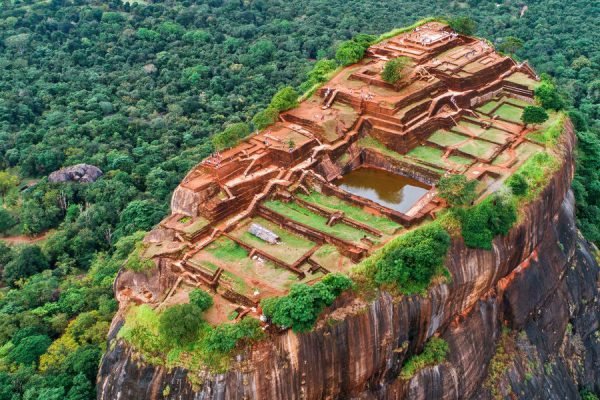
Location : Central Province, Sri Lanka
Coordinates: 07°57′25″N 80°45′35″E
Elevation : 349 m
Avg temperature : 25 C to 32 C
Humidity : 75%
Built for : Royal Palace
Visitors : 1 million anually
Governing body : Government of Sri Lanka
Website : https://sigiriyafortress.com/
Official name : Ancient City of Sigiriya
Type : Cultural
Criteria : ii, iii, iv
Designated : 1982 (6th session)
Reference no. : 202
UNESCO Region : Asia-Pacific
Sigiriya is one of the eight world heritage sites in Sri Lanka declared by UNESCO in 1982. UNESCO ranks Sigiriya as the 8th Wonder of the World, and once you see it, you’ll completely understand. According to archaeologists and historians, “Sigiriya is a ‘unique combination of the fifth-century urban planning, landscaping, hydraulic management, architecture, engineering, painting, sculpture and poetry. Some say 5000 years before, King Ravana used it as his palace on the summit and to land his vimana(helicopter) on top of the Sigiriya rock. He used Sigiriya rock as a Helipad according to folklore and Ramayanaya.
The Sigiriya builders follow two main concepts.
● To conserve or enhance the environment
● To maintain symmetrical presentations
According to the weather patterns in Sri Lanka, Sigiriya belongs to the dry zone. The 10th and 9th centuries BC, the protohistoric transformation occurred in the Sigiriya region. Humans used to live there, but they turned from foraging to agriculture. People understood they could make a plant from seed during this period.
Historical past
The area around Sigiriya has likely been inhabited since prehistoric times. There is clear evidence that Buddhist monks and ascetics occupied the many rock shelters and caves in the vicinity from as early as the 3rd century BC. The earliest evidence of human habitation at Sigiriya is the Aligala rock shelter to the east of Sigiriya rock, indicating that the area was occupied nearly five thousand years ago during the Mesolithic Period.
Buddhist monastic settlements were established during the 3rd century BC on the western and northern slopes of the boulder-strewn hills surrounding the Sigiriya rock. Several rock shelters or caves were created during this period. These shelters were made under large boulders, with carved drip ledges around the cave mouths. Rock inscriptions are carved near the drip ledges on many of the shelters, recording the donation of the shelters to the Buddhist monastic order as residences. These were made between the 3rd century BCE and the 1st century AD.
In 477 AD, the local king Kashyapa 1, Sigiriya was developed into a complex city and fortress during King Kashyapa’s reign (477 to 495 AD). Most elaborate constructions on the rock summit and around it, including defensive structures, palaces, and gardens, date from this period. Archaeological evidence shows that the Sigiriya king had foreign relations with Persia, China and Rome.
According to the historical evidence, the monastery was there till the 13th century when it was lost to the jungle. But the name Sigiriya continued.
During the 19th C., Buddhist monks established a temple at Pidurangala mountain (beside Sigiriya rock) and began to take an interest in the Sigiriya site. 1894, the archaeological commissioner H.C.P. Bell commenced the excavation, and the successive archaeological commissioner, Prof. S. Paranawithana, continued and conserved it to the present situation.
Sigiriya today
The monolith rock was formed from the magma of an extinct volcano and remains a residual mountain. It is named Sigiriya because of the shape of the rock and due to the later developments by King Kasyapa. He added a lion’s mouth, and people had to go through the mouth. In Sinhala, “Sinha giri”, which means ‘lion mountain’ or ‘lion’s mouth’ became Sigiriya. It is wrongly described as a fortress, but it is a well-planned multifaceted royal city with a palace on the summit of the 200meter high rock, an extensive assemblage of buildings, parks, ponds, pathways, etc., covering an area of more than 15 hectares enclosed by ramparts and moats. There are 1350 stairs to climb onto the summit. The history of Sigiriya can be divided into three eras.
Pre Kasyapa era – Epic Ramayana, Monastery from 3rd C BC -5th C AD
Kasyapa era – 18 years 477-495 AD
Post Kasyapa era – Monastery up to 13th C AD lost to the jungle and modern period
We have written a blog post about Ramayana trails in Sri Lanka, including Sigiriya, for those interested. The link follows immediately,
The Sigiriya palace complex consists of several parts,
- The inner and outer city
- Western, Southern, and Northern entrances. (citadel extends about 18 sq km)
- Pleasure gardens
- Frescoes
- Graffiti on the Mirror wall
- Lion’s paw
- Summit
The inner and outer city
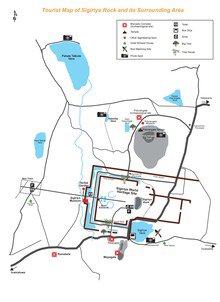
It is believed that the present unexcavated area of the Eastern part of the rock is the inner and outer city. The inner-city measures about 700m from east to west and 500m from north to south, with a high earthen rampart, gateways and buried moat. On a low rock crop in the centre of the inner city is evidence of a pavilion directly aligned with the eastward-oriented throne on the summit, suggesting that this area was a ceremonial precinct connected visually and symbolically with the palace on the top of the rock. Beyond this inner city is the outer city area, a rectangular about 1500 by 100 meters. Excavations revealed a suburban settlement. The eastern side of the rock was the metropolis of the Sigiriya complex, where the bulk of the city’s population lived: nobles, officials, trades, craftsmen, soldiers, servants and enslaved people”.
Western, Southern, and Northern entrances.
Three ramparts and two moats, very well mark out the inner city. The citadel extends about 18 sqkm.) The above three entrances can be seen. The western entrance has been excavated and preserved. It is regarded as an exclusive gate to the water gardens with a draw bridge. The moats were fed by the waters of the reservoir (tank). The inner and middle ramparts had tiled roofed walkways along their length. The central and outer ramparts were incomplete and suddenly halted with the sudden and dramatic termination of Kasyapa’s reign. Northern and Southern gateways were large enough for the vehicular traffic.
Pleasure Gardens
This is considered one of the historic and oldest surviving gardens in Asia.
The pleasure gardens can be divided into three.
• Water gardens
• Boulder gardens
• Terrace gardens
Water gardens

The water gardens of Sigiriya represent a symmetrical pattern, and every water pond is connected. When it’s raining, water flows from one to the other, and excess water goes to the moat. According to the chronicle Mahavamsa (the book about Sri Lanka’s history), the outer moat is filled with crocodiles. The left side of the water garden is not excavated and is left for the next generation to do. Another important fact is that the king can easily visit every water pond without climbing up and down. Chronicles and folklore mentioned that most water ponds had water purification systems and were imprinted with the natural fragrance. King had bathing and water sports in those water pools with his queens and harem.
As mentioned earlier, Sigiriya belongs to the dry zone of Sri Lanka, and most of the year, it is almost nine months hot and humid; therefore, King Kasyapa used these water pools or ponds to cool the atmosphere. In the rainy season, 1400 years old, four water fountains in the water garden still pop up. Next to the water fountains, you get the serpent waterways, which retain the water, cleaning the waterway and cooling the place.
Some of the water fonds are in char-Bhar style in Persia. Then again, we can assume that king Kasyapa had a relationship with the other countries and knowledge of the outer world in 5th C AD.
The water gardens, cave and boulder gardens, and terrace gardens at Sigiriya are among the oldest landscaped gardens in the world, so be sure to take some time to appreciate them!
Boulder Gardens

Terrace gardens

Frescoes/ Paintings

Graffiti on the mirror wall

Lions Paw/ Lions Staircase
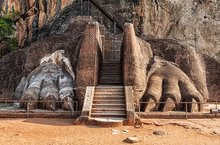
Summit
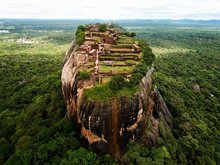
Conclusion
With its rich history, stunning architecture, and breathtaking views, Sigiriya Rock is a must-visit destination for anyone travalling Sri Lanka. This UNESCO World Heritage site offers a unique opportunity to step back in time and immerse yourself in the ancient wonders of this beautiful island nation.
Whether you are a history enthusiast, an architecture lover, or simply someone who appreciates natural beauty, Sigiriya Rock will leave you in awe. So, plan your visit to this remarkable site and create memories that will last a lifetime.
These messages (Sigiri graffiti) from the past can cause a frisson when read by visitors today. One reads: “At Sigiriya, of abundant splendour, situated on the island of we saw, in a happy mood, the rock that captivates the mind of all people who come here.”
The visitors today also tend to be smaller in the afternoon as many tour groups visit in the morning (before moving on to the next destination), and there’s also the additional bonus of watching the sunset once you get to the top! Make sure you purchase your ticket before the entrance closes at 5 P.m.
SIGIRIYA CLIMBING TIPS
- Be sure to take a bottle of water and keep yourself hydrated. Don’t forget there are 1350 stairs to climb. The last place to buy water is a canteen near the main entrance.
- Wear comfortable, breathable clothes as the Sigiriya Lion Rock climb is a workout.
- Wear sunglasses if you are climbing in the noon.
- Use sunscreens if you are climbing in the noon.
- Always keep your attention on the steps. In some areas, the slope is quite steep.
- Start your climb as early as in the morning to avoid sun heat.
- Keep your valuable items safe. Some monkeys might steal your food items.
- Beware of heavy winds and keep your belongings safe (Camera, sunglasses, hats and caps)
- Always obey the road signs and instructions.
- If you climb Sigiriya Lion Rock in the morning, take the museum tour afterward.
CRUCIAL DONT’S AT SIGIRIYA ROCK
- Do not take pictures at Sigiriya Frescoes at any chance. This is a serious punishable offense.
- Drones are STRICTLY prohibited within Sigiriya Lion Rock premises. This is a severely punishable offense. Hornets get disturbed by the sound of a drone.
- Do not feed animals, especially monkeys, and deer, while you climb Sigiriya Lion Rock.
- Do not make colossal noise. Hornet nests are there in the surroundings. They won’t disturb you until you upset them.
- Do not walk on ancient building ruins in Sigiriya Fortress, and if you see someone, please advise.
- Do not write anything anywhere unless it’s the log book in the museum.

Hope you enjoyed the article. You can scroll down to our featured posts. Before you go to featured posts, Subscribe to read our new posts. We never use this email for promotions and offers. Our only purpose is for you to read our valuable content.
Featured Blog Posts

- Featured, Places
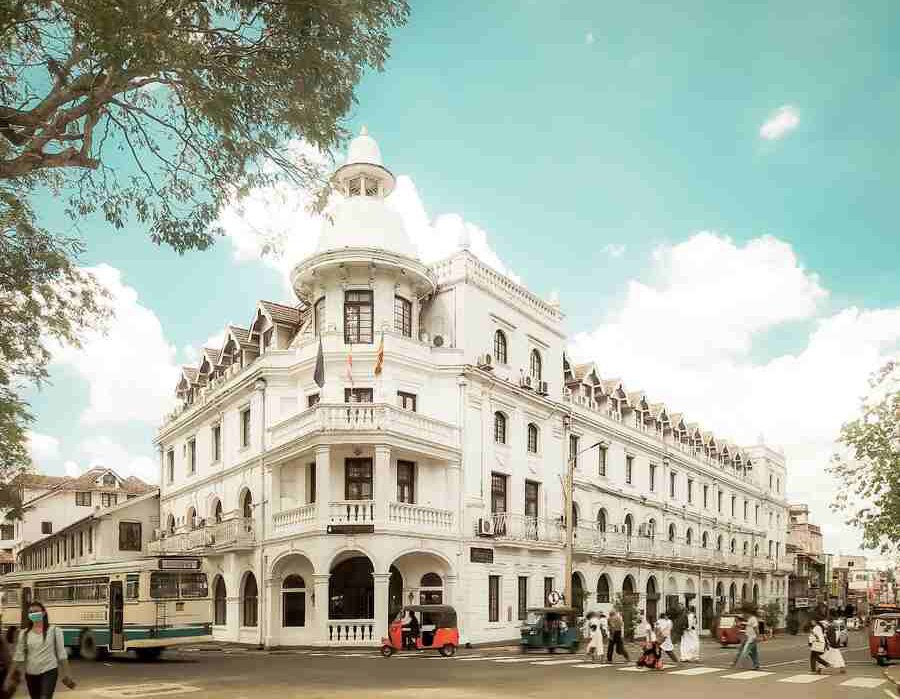
- Featured, Places

- Featured, Travel tips

- Featured, Places

- Activities, Featured

- Activities, Featured, Wild life
